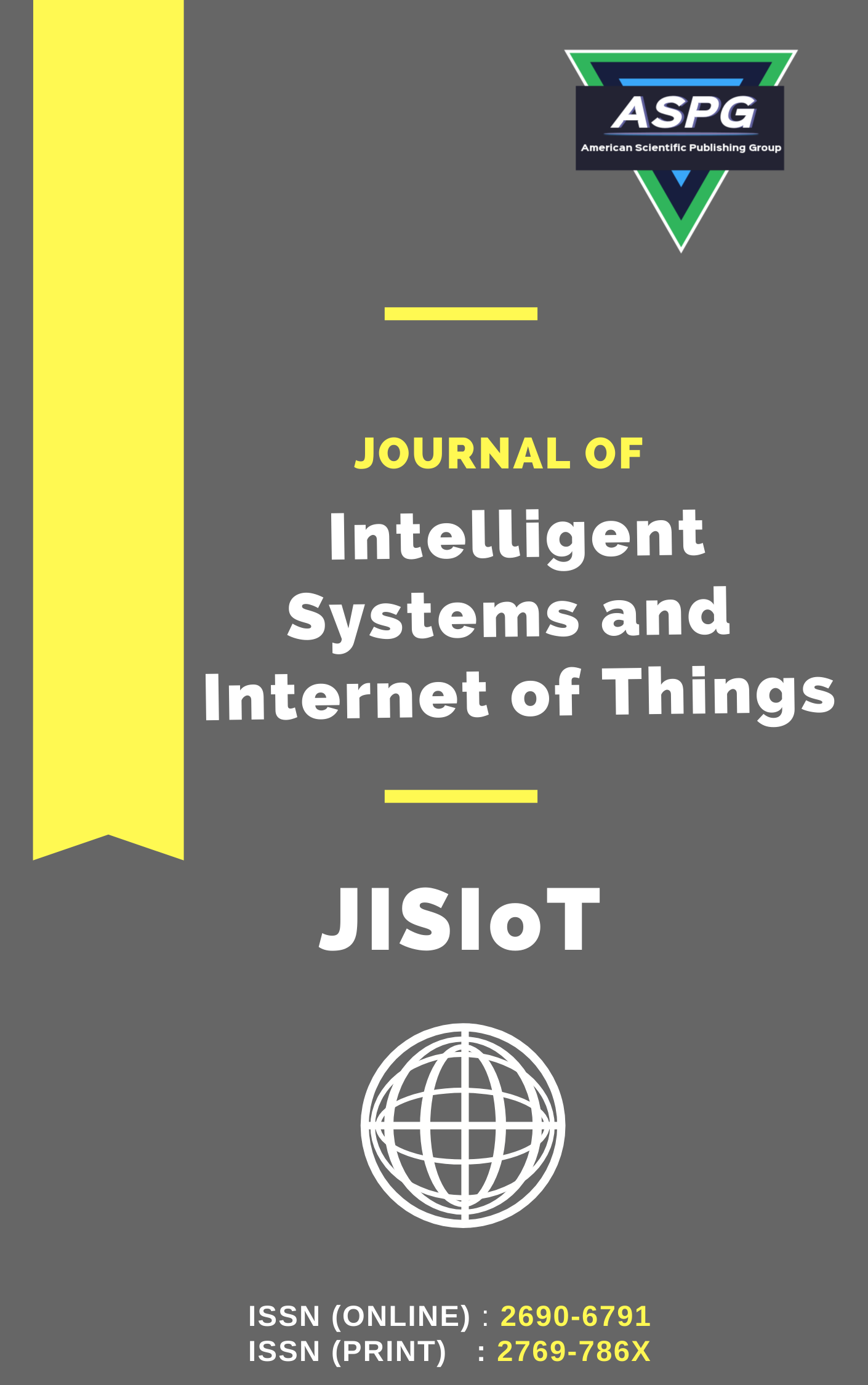

Volume 18 , Issue 2 , PP: 122-129, 2026 | Cite this article as | XML | Html | PDF | Full Length Article
Sánchez-Juárez J. R. 1 , Aldana-Franco R. 2 * , Leyva-Retureta, J. G. 3 , Álvarez-.Sánchez E. J. 4 , López-Velázquez A. 5 , Aldana-Franco F. 6 *
Doi: https://doi.org/10.54216/JISIoT.180209
The transmission of energy is one of the main tasks of Electrical Engineering. Transmission lines are used for this purpose, which are susceptible to various problems such as short-circuit, overload, open circuit, and complex faults. From the perspective of smart grids, one of the open challenges is to have autonomous systems that allow the detection, classification, and location of faults in transmission lines. On the other hand, Artificial Neural Networks are computational tools used in classification and control tasks to be applied to different plants and systems. There are several ways to solve problems using ANNs; one is modularity. This strategy consists of dividing the problem into components that are easier to classify. In this way, a modular system is proposed that is composed of three ANNs: One for detection, one for classification, and one more for the location of faults in transmission lines. A simulation model of a three-phase electrical power system was built using Simulink MATLAB, employing a data transmission approach typical of smart grids. Supervised learning and WEKA software were used for network training. Databases were created using the potential difference and line current, as well as the ground fault impedance. The database was developed through cases and mathematical models, and the performance of the networks was evaluated in the simulated model. The results show that the proposed model allows the identification of all cases presented in the test stage (100%), which is a better performance than a single neural network (81.25%) that is responsible for detecting, classifying, and locating faults.
Modular Artificial Neural Networks , Transmission Lines , Power system failures , Smart Grids
[1] N. Ahmed, A. A. Hashmani, S. Khokhar, M. A. Tunio, and M. Faheem, “Fault detection through discrete wavelet transform in overhead power transmission lines,” Energy Sci. Eng., vol. 11, no. 11, pp. 4181–4197, 2023.
[2] I. Mashal, “Smart grid reliability evaluation and assessment,” Kybernetes, vol. 52, no. 9, pp. 3261–3291, 2023.
[3] M. Javaid, A. Haleem, R. P. Singh, R. Suman, and E. S. Gonzalez, “Understanding the adoption of Industry 4.0 technologies in improving environmental sustainability,” Sustain. Oper. Comput., vol. 3, pp. 203–217, 2022.
[4] S. Huang, B. Wang, X. Li, P. Zheng, D. Mourtzis, and L. Wang, “Industry 5.0 and Society 5.0: Comparison, complementation and co-evolution,” J. Manuf. Syst., vol. 64, pp. 424–428, 2022.
[5] T. Kotsiopoulos, P. Sarigiannidis, D. Ioannidis, and D. Tzovaras, “Machine learning and deep learning in smart manufacturing: The smart grid paradigm,” Comput. Sci. Rev., vol. 40, p. 100341, 2021.
[6] J. J. Moreno Escobar, O. Morales Matamoros, R. Tejeida Padilla, I. Lina Reyes, and H. Quintana Espinosa, “A comprehensive review on smart grids: Challenges and opportunities,” Sensors, vol. 21, no. 21, p. 6978, 2021.
[7] M. A. Khan, A. M. Saleh, M. Waseem, and I. A. Sajjad, “Artificial intelligence enabled demand response: Prospects and challenges in smart grid environment,” IEEE Access, vol. 11, pp. 1477–1505, 2022.
[8] T. Ahmad, R. Madonski, D. Zhang, C. Huang, and A. Mujeeb, “Data-driven probabilistic machine learning in sustainable smart energy/smart energy systems: Key developments, challenges, and future research opportunities in the context of smart grid paradigm,” Renew. Sustain. Energy Rev., vol. 160, p. 112128, 2022.
[9] M. Subhrajit, M. Rajarshi, and C. Paramita, “PSO driven designing of robust and computation efficient 1D-CNN architecture for transmission line fault detection,” Expert Syst. Appl., vol. 210, p. 118178, 2022.
[10] A. L. Pérez, I. R. P. Maliuk, and O. P. Maliuk, “Electrical Losses in Primary Distribution Networks: Case in Holguin Province,” Indones. J. Comput. Eng. Des, vol. 5, no. 1, pp. 26–33, 2023.
[11] F. Rafique, L. Fu, and R. Mai, “LSTM autoencoders based unsupervised machine learning for transmission line protection,” Electr. Power Syst. Res., vol. 221, p. 109432, 2023.
[12] S. Mittal, Y. Bengio, and G. Lajoie, “Is a modular architecture enough?” Adv. Neural Inf. Process. Syst., vol. 35, pp. 28747–28760, 2022.
[13] E. Augello, D. Masotti, and A. Costanzo, “Modular Artificial Neural Networks for Wireless Power Transfer Optimization in Sensor-Driven Industrial IoT,” in Proc. IEEE Wireless Power Technol. Conf. Expo. (WPTCE), 2025, pp. 1–5.
[14] A. Laurencio-Pérez, I. Pérez-Maliuk, and M. Pérez, “Evaluation of losses in electrical subtransmission networks by neural network modeling,” DYNA, pp. 78–83, 2022.
[15] S. Alsubhi, K. Laabidi, and L. Hsairi, “Comparison of Several Artificial Neural Network Approaches for Fault Classification in Power Transmission Lines,” in Proc. 7th Int. Conf. Eng. MIS, 2021, pp. 1–6.
[16] A. Turki and M. Chtourou, “A neuro-fuzzy modular system for modeling nonlinear systems,” J. Algorithms Comput. Technol., vol. 18, 2024.
[17] S. Gil, G. D. Zapata-Madrigal, R. García-Sierra, and L. A. Cruz Salazar, “Converging IoT protocols for the data integration of automation systems in the electrical industry,” J. Electr. Syst. Inf. Technol., vol. 9, no. 1, p. 1, 2022.
[18] S. Shukla, M. F. Hassan, D. C. Tran, R. Akbar, I. V. Paputungan, and M. K. Khan, “Improving latency in Internet-of-Things and cloud computing for real-time data transmission: a systematic literature review (SLR),” Cluster Comput., vol. 26, no. 5, pp. 2657–2680, 2023.
[19] F. M. Shakiba, M. Shojaee, S. M. Azizi, and M. Zhou, “Real-time sensing and fault diagnosis for transmission lines,” Int. J. Netw. Dyn. Intell., pp. 36–47, 2022.
[20] I. Diahovchenko, M. Kolcun, Z. Čonka, V. Savkiv, and R. Mykhailyshyn, “Progress and challenges in smart grids: distributed generation, smart metering, energy storage and smart loads,” Iran. J. Sci. Technol. Trans. Electr. Eng., vol. 44, pp. 1319–1333, 2020.
[21] S. R. Fahim, S. K. Sarker, S. M. Muyeen, S. K. Das, and I. A. Kamwa, “A deep learning based intelligent approach in detection and classification of transmission line faults,” Int. J. Electr. Power Energy Syst., vol. 133, p. 107102, 2021.